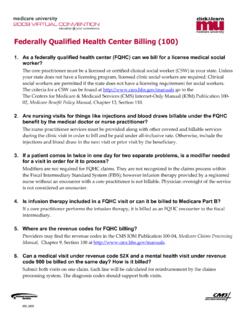Transcription of RIPRAP DESIGN FOR OVERTOPPED EMBANKMENTS
1 FINAL REPORT. RIPRAP DESIGN FOR OVERTOPPED . EMBANKMENTS . Prepared by Mishra and James F. Ruff Colorado State University Engineering Research Center Prepared for Bureau of Reclamation October, 1998. ABSTRACT. RIPRAP DESIGN FOR OVERTOPPED EMBANKMENTS . The flood potential at a dam and the resulting likelihood of dam failure must be evaluated as part of the DESIGN flood selection process. The DESIGN flood must be selected before requirements for additional spillway capacity or overtopping protection can be designed. Overtopping means using all, or a portion of, the dam crest length as an emergency spillway. Innovative overtopping protection systems for dams are being studied throughout the world. It is the hope that these studies will reduce cost and still provide a reliable level of safety to both new and existing dams.
2 Research programs are currently underway or planned for evaluating overtopping protection concepts. If these new advancements were better known, dam owners may be more inclined to improve the level of protection of their dams at a reasonable cost. In the construction of the new dams and rehabilitation of existing dams, RIPRAP is usually the most economical material for erosion control. Currently, testing of large RIPRAP sizes is lacking. Experiments have been conducted in laboratories without producing results allowing application to a full-scale dam with confidence. To address this problem, the United States Bureau of Reclamation and Colorado State University (CSU) built a near- prototype embankment overtopping facility at CSU's Engineering Research Center in 1991.
3 Three sizes of large RIPRAP were tested on the overtopping facility in the summers of 1994, 1995, and 1997. RIPRAP gradations were obtained. Interstitial velocities of water through the rock layer as well as the flow depths were recorded for each test. These data were compared against the available RIPRAP DESIGN equations. The need to develop a universal RIPRAP DESIGN equation for any slope specifically steep slopes was established. The gathered data were analyzed. A new universal RIPRAP DESIGN equation was developed. Finally, an innovative RIPRAP DESIGN procedure was outlined. ACKNOWLEDGMENTS. Our appreciation to Ms. Kathleen Frizell and USBR Contract #1425-1-FC-81-17790. and Contract #1425-96-FC-81-05026, and the Colorado State University Agricultural Research Center Contract #C0L00708 for the funding support of this research and the completion of this report.
4 11. TABLE OF CONTENTS. Page ABSTRACT i ACKNOWLEDGMENTS ii LIST OF TABLES v LIST OF FIGURES vi LIST OF SYMBOLS viii Chapter 1: Introduction 1. The Purpose of the Current Study 3. Chapter 2: History of embankment Protection Studies 4. embankment Overtopping Protection Methods 4. Literature Review 6. NRC/CSU Studies for RIPRAP DESIGN 12. ARS RIPRAP Tests 13. Need for Future Research 14. Chapter 3: Experimental Facilities, RIPRAP Characteristics, and Data Acquisition .. 15. Overtopping Facility 15. Characteristics of the Bedding Material 19. Characteristics of the RIPRAP Materials Tested 19. General Operating Procedures 21. Instrumentation and Data Acquisition 22. Chapter 4: Flow Observation 28. RIPRAP Flow Conditions 28. Flow Observations in 1994 and 1997 28.
5 Flow Observations in 1995 31. Chapter 5: Data Analysis 35. Analysis of Salt Injection Method 35. Analysis of Piezometer Data 37. Velocity Calculation From Piezometer Data of 1994 and 1995 43. Velocity Calculation From Piezometer Data of 1997 43. Comparison of Interstitial Velocity Calculated From Two Methods .. 43. iii Chapter 6: Development of a Predictive Equation for Interstitial Velocity of Water Through RIPRAP 45. Need for Developing a New Predictive Equation for Interstitial Velocity of Water 45. Results From the Current Test Program 45. Chapter 7: Description of RIPRAP Failure and Toe Treatment 49. Failure of RIPRAP 49. Toe Treatment Test Program 53. Chapter 8: Development of the RIPRAP DESIGN Equation 57. Development of DESIGN Guidelines 57.
6 Shield's Parameter 57. Derivation of the Universal Equation 63. Sensitivity Analysis 73. RIPRAP Layer Thickness and Slope Influence 73. Chapter 9: DESIGN Procedure and Examples 79. DESIGN Procedure 79. Example 1 81. Step by Step Solution 81. Example 2 83. Step by Step Solution 83. Chapter 10: Summary, Conclusions, and Future Research 85. Summary 85. Conclusions 86. Scope of Future Research 87. References 88. Appendix A: Interstitial Velocity Data 90. Appendix B: Manometer Data 108. iv LIST OF TABLES. Page Table Mean stone diameters 2. Table RIPRAP gradation for bedding layer of 1997 (D50 = mm) 19. Table RIPRAP gradation for 1994 tests (D50 = 386 mm) 20. Table RIPRAP gradation for 1995 tests (D50 = 655 mm) 20. Table RIPRAP gradation for 1997 tests (D50 = 271 mm) 21.
7 Table Comparison of interstitial velocities obtained by two methods 44. Table Interstitial velocities 46. Table RIPRAP failure characteristics 53. Table Deviation factors cs 69. LIST OF FIGURES. Page Figure Free body diagram of a rock in a horizontal plane 9. Figure Free body diagram of a rock in water flow on an inclined plane 10. Figure Overtopping facility at CSU 15. Figure RIPRAP test layer configuration in 1994 and 1995 17. Figure RIPRAP test layer configuration in 1997 18. Figure Grid used for sampling rocks 20. Figure Schematic drawing of injectors, conductivity probes, and piezometer locations 23. Figure Plan view of the piezometers, injectors, and conductivity probes 24. Figure 1994 layout with the piezometer towers on the RIPRAP slope before testing 25.
8 Figure 1995 layout with the piezometer towers on the RIPRAP slope before testing 25. Figure 1997 layout of the RIPRAP slope with the piezometer towers before testing 26. Figure Numbering of rocks in 1995 27. Figure Transition of flow into the chute at Q = m3/s, 1994 29. Figure Flow becoming turbulent as it encountered the rock layer at Q = m3/s, 1994 29. Figure Visible surface water looking downstream at Q = m3/s, 1997 .. 30. Figure Wet and dry areas of RIPRAP surface at Q = m3/s, 1997. (flow from top to bottom) 30. Figure Wet and dry areas of RIPRAP surface at window #2, Q = m3/s, 1994 31. Figure Flow (left to right) pattern due to obstruction of flow path seen through window #2 (Q = m3/s) 32. Figure Cascading flow (flow direction from top to bottom) (1994) 33.
9 Figure Water surface profile over the RIPRAP gabion (Q = m3/s) 33. Figure Large plumes of water (1995) (Q = m3/s) 34. Figure Schematic of the velocity zones (1995) 34. Figure Typical voltage drop indicating the interstitial flow velocity for the tests 36. Figure Typical voltage drop seen in the bedding layer in 1997 or near the bottom layer for 1994 and 1995 37. Figure Schematic drawing of piezometer-manometer configuration 37. vi Figure Variation of depth of flow with unit discharge in 1994 and 1995 .. 39. Figure Variation of depth of flow with unit discharge in 1997 40. Figure Photograph showing the profile of water flow through the RIPRAP layer of 1994 41. Figure Photograph showing the profile of water flow through the RIPRAP layer of 1995 42.
10 Figure Comparison of current formula and formula by Abt et al. with existing data 48. Figure Failure of 1994 RIPRAP layer located m from the crest of the flume down the slope 50. Figure Several rocks of 1995 RIPRAP layer caught in the trap (looking downstream) 51. Figure Failure of 1995 layer showing removal of the top layer 51. Figure Channelization in 1997 RIPRAP layer with dislodgement of rocks 52. Figure Failure of 1997 layer at m from the crest down the slope 52. Figure Schematic diagram of the toe shapes and sizes tested in 1997 54. Figure Wire mesh covering the RIPRAP 55. Figure Catastrophic failure 56. Figure Shield's diagram (adapted from Julien, 1995) 58. Figure Robinson et al. RIPRAP DESIGN equation 59. Figure Closeup view of Robinson et al.
















